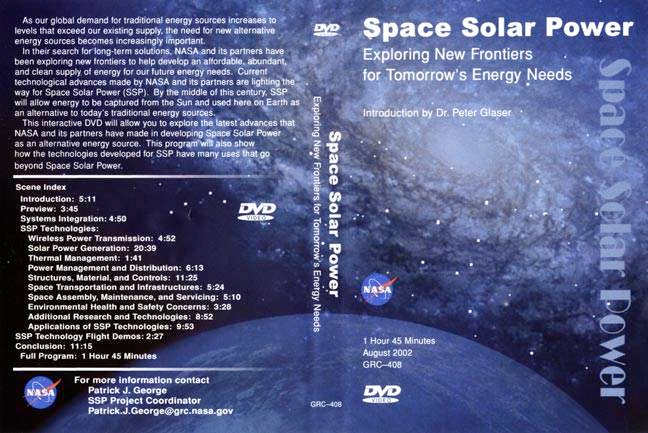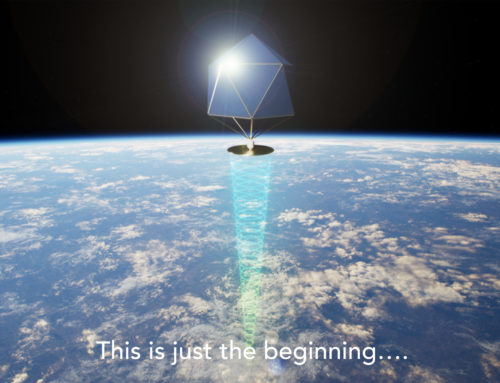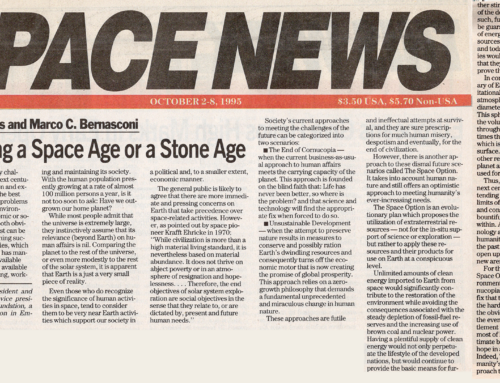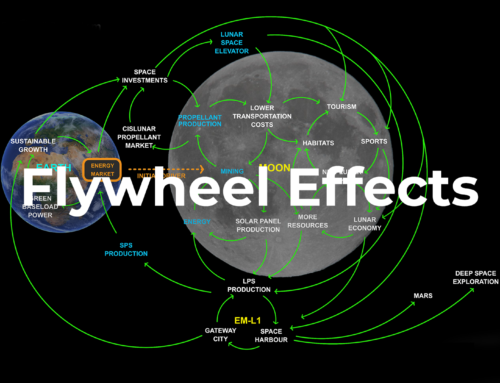Part 8: SSP Technologies: Structures, Materials, and Controls
- Introduction – John Mankins
- Inflatable Structures and Materials
- Inflatable Trusses
- Isogrid Boom
- Other Inflatable Structures
- Hexapod
YouTube Link (11:32): https://www.youtube.com/watch?v=t3nRfGUwHs4
Transcript of video:
Introduction – John Mankins
Transporting anything to space and in space is an expensive proposition. Therefore, NASA is developing extremely lightweight, collapsible structures that could be used to build many of the parts of future SSP platforms. Moreover, in many ways space is an extremely harsh environment. Therefore, the materials from which the framework of an SSP platform is built must be able to withstand its rigors and to do so through decades of operations. Here you’ll see some of the inflatable, space qualified structural concepts that NASA has developed for use in future SSP systems
Inflatable Structures and Materials
NASA is developing advanced structures and materials technology for space solar power systems. Large space solar power satellites will be constructed from thousands of pieces launched into orbit. These pieces will be joined together by astronauts and robots to form the primary structure of the satellite. The primary structure supports the giant reflectors at each end of the satellite, that collect and focus sunlight: the solar arrays that generate electricity and the microwave transmitting antenna that beams power down to earth.
At NASA, researchers are developing new concepts for lightweight structural elements, such as inflatable trusses. Inflatable structures can be folded up into much smaller packages than other types of deployable structures. Many of these small packages can fit on a single rocket. This reduces the number of rocket launches required to construct the solar power satellite and lower the cost. After reaching orbit, the structural elements are inflated like a balloon to form large truss sections.
The truss sections are then rigidized, so that it is not necessary to maintain pressure in the structure to hold its shape. During rigidization, the composite material in the structure becomes stiff. Some types of inflatable structures are rigidized by heat. Other types are rigidized by cooling or by ultraviolet radiation from the sun. Once the truss sections have been rigidized, they are assembled to make larger beams and girders, which are used to construct the backbone of the solar power satellite.
The backbone of a large power satellite may be several kilometres long. It holds the solar reflectors in the proper orientation so that they focus sunlight onto the solar arrays
Inflatable Trusses
Researchers at NASA are investigating structures, trying to improve our understanding of how these structures perform, and how they can be scaled up to larger sizes.
This is an inflatable rigidizable tube. It has already been inflated and rigidized very much like it would be on orbit. But before it gets to that state, it starts out as a packaged rolled up piece of composite fabric. It is taken to orbit and then it is inflated very much like this party favour. And then it is rigidized to a very various methods on orbit it can also be folded very much like an accordion where it folds out and is inflated and also rigidized.
Many tests are conducted in the laboratory to measure the strength and stiffness of inflatable booms and trusses. In these tests, a steadily increasing compressive load is applied to the structure until it fails. The test data is used to validate mathematical models which will be used for the design and analysis of structures for space solar power systems.
This is an inflatable rigidizable truss structure. It is composed of these inflatable rigidizable tubes The advantage of this structure is that it can be compressed into a very small packaging space. When it is launched to orbit it can then expand into this large truss structure. It is very stiff after it has been rigidized and then it can be it can take quite a bit of load. We have actually tested this structure, and it handled five hundred and fifty pounds of load which is quite a bit considering it only weighs approximately ten pounds and it’s very lightweight. So that it actually handles fifty times its weight in load.
Isogrid Boom
In addition to inflatable truss sections for the satellite backbone, lightweight deployable structures are needed to support the solar arrays. An isogrid boom is an inflatable boom that is fabricated by wrapping carbon fibers in a spiral pattern around a cylinder. The fibers are bonded together where they intersect to form a sparse network with open spaces between the fibers. Because it uses less material, an isogrid boom is lighter than a simple tube, but it has almost the same strength since the fibers are placed only where they are needed to carry the load. Isogrid booms are developed for lightweight solar arrays.
The isogrid column is a very lightweight structural concept. In particular this three-meter column can hold up to one hundred pounds of axial compressive load and yet weighs only six ounces. The column is made of thermoplastic epoxy and carbon graphite fibers. The thermoplastic materials become pliable when heated above the glass transition temperatures. So, this column can be packaged simply by heating it and rolling it up. To demonstrate deployment, a three-meter column was deployed in a thermal vacuum chamber. The temperature inside the chamber was very cold at one hundred and thirty-five degrees Celsius below zero.
The cold temperature and vacuum inside the chamber simulated the environment of space where the column will be deployed when it becomes operational. A column was coiled inside the gold box which was actually an insulated oven designed to warm the bundled structure. When the calms core reached a very hot temperature of eighty degrees Celsius inside the oven, a minuscule amount of nitrogen gas was released into the column. In a vacuum the gas expands rapidly to fill a large volume with a force grade enough to fully extend the column in just a few seconds
Other Inflatable Structures
Concepts for inflatable deployable space structures have been under development and evaluation for almost fifty years as exemplified by the Echo balloon, built launched and deployed in the early sixties. The approach offers low-cost hardware, exceptional packaging efficiency, deployment reliability and very low mass. These features remain attractive in potential applications such as solar sails, large antennas, and structural elements in space solar power concepts. Recent technology developments introduce materials and digitization techniques to form many components including trusses, joints, reflectors, and special purpose components.
An example is shown of inflatable antenna experiments fourteen-inch diameter ninety-five-foot-long beam in its pre-deployment package of thirteen inches.
The inflatable antenna experiment or IAE is the most remarkable demonstration to date of an inflatable rigidizable technology. More than a demonstration of antenna technology, it is a demonstration of applications. Inflatable structures offer the same benefits to space solar power and are especially attractive given the kilometers long size required for SSP solar collectors, concentrators, radiators, and other components and frameworks. Crucial to the next generation of inflatable devices is the development of truss and joint configurations capable of sustaining the shape and function of supported components. A full-scale truss section pictured here, provided initial determinations of material and mechanical properties of very-large sized inflatable space structures.
For SSP a rigidizable truss was constructed consisting of three tubes or longerons, one- and one-half inches in diameter forty inches long. Each two made of three-ply carbon fiber laminates was folded and stowed with the diagonals attached. This element or bay was then inflated and rigidized with an embedded thermostat plastic. The test result showed a high degree of straightness, uniformed circular cross sections, and highly compatible tube and joint dimensional repeatability.
These successes demonstrate that current technology enables large structures. Further effort will increase packaging efficiency, extend materials life, standardized manufacturing processes, and integrate deployment and control features permitting an entire class of inflatable structures for a broad range of space applications, including those of space solar power.
Hexapod
Because inflatable and membrane structures are very large and lightweight, they will also be very flexible. This means that the structures will tend to vibrate when disturbed by small external forces. These vibrations can prevent the solar power satellite from accurately tracking the sun, which is critical for collecting solar energy efficiently. In addition, the surface of the microwave transmitting antenna must be kept very flat so that the beam is not distorted. Researchers are working on concepts for suppressing unwanted structural vibrations and for controlling the flatness of large apertures like the antenna. These new control methods are demonstrated on a smart structures test bed called a hexapod. The hexapod consists of a three-meter diameter reflective membrane suspended in an inflatable frame. Pizoelectric actuators are embedded in the inflatable frame to dampen out its flexible dynamics. Other actuators are attached to the reflective membrane to adjust its tension and to control its flatness.
As part of the space solar power activity that we’ve been working on there are two problems that we that we are concentrating on one is uh vibration control of membrane and vibration control of the inflatable rigidizable structures like the one we have here. This past year we spent quite a bit of time looking at actuators that would allow us to do vibration control of membrane structures.
This actuator I have here is the first prototype of such a system. It will be mounted on this structure like this, and it allows you to do in plain tension control and allows you to do auto plane vibration control and our hope is to fit this particular structure with actuators so that we can demonstrate our ability to control a membrane like this. The second problem we have been working on, is the actual vibration control of the overall system. And for that we have chosen the NASA developed microfiber composite actuator which is a very paper like actuator that was bonded on the structure at key locations, and this would allow us to control the vibration of the overall configuration.
Space Solar Power: Exploring New Frontiers for Tomorrow’s Energy Needs
As our global demand for traditional energy sources increases to levels that exceed our existing supply, the need for alternative energy sources becomes increasingly important. In their search for long-term solutions, NASA and its partners have been exploring new frontiers to help develop an affordable, abundant, and clean supply of energy for our future energy needs.
Current technological advances made by NASA and its partners are lighting the way for Space Solar Power (SSP). By the middle of this century, SSP will allow energy to be captured from the Sun and used here on Earth as an alternative to today’s traditional energy sources.
The interactive DVD will allow you to explore the latest advances that NASA and its partners have made in developing Space Solar Power as an alternative energy source. This program will also show how the technologies developed for SSP have many uses that go beyond Space Solar Power.

DVD, 2002. (1 hour 45 minutes total)
NSS Link: https://nss.org/space-solar-power-exploring-new-frontiers-for-tomorrows-energy-needs-nasa-video/






